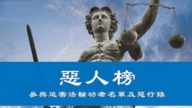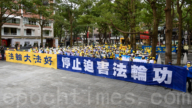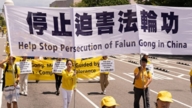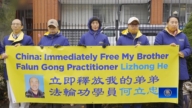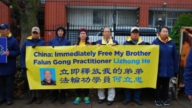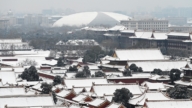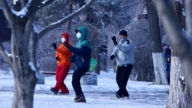【新唐人2013年11月02日訊】北京天安門汽車爆炸事件發生後,中共當局立即對事發現場進行了嚴密封鎖,甚至扣押了多名在場的外媒記者,之後又發出禁令,嚴控傳媒及網路消息。中共對於這類突發事件所採取的一貫處理手段,與12年前,同樣發生在天安門前的一起自焚案截然不同。12年前中共在自焚事件發生之後迅速報導,並且播放了現場拍攝完整的錄像,長時間對民眾宣傳。
震驚中南海的北京天安門汽車爆炸案發生後,引發了全球媒體的關注,但中共當局不但立即出動大量軍警封鎖了現場,中南海附近的主幹道也拉起了警戒線﹔地鐵、公交車不得在天安門站停靠。
當天有6名香港記者在事發現場採訪被扣留15分鐘,並與公安激烈爭辯。《法新社》兩名記者也被拘留,記者所拍攝的影像被強迫刪除。
另一方面,中共國務院網路信息辦公室向各大網站發出報導禁令,使得大陸網站和微博幾乎看不到爆炸案的相關消息和評論。
中共當局對爆炸事件的嚴密封鎖,使人們聯想到12年前同樣發生在天安門廣場的自焚事件。
「追查迫害法輪功國際組織」負責人汪志遠:「這一次在天安門發生的車輛碰撞事件,和2001年1月23日發生的所謂天安門自焚事件,中共的報導和處理方式顯然是不一樣的,這一次事件發生以後是全面的封鎖消息,而那一次,中共是在事件發生之後迅速報導,而且播放了現場的錄像,並且還有特寫鏡頭。在以後的很長一段時間內,在全世界範圍內大肆的宣揚。」
顯然,中共處理當年所謂「法輪功自焚事件」的手法,完全不符合中共當局處理突發事件的一貫態度。這一點,從近年來不斷發生訪民在天安門前自焚的事件也可以得到證實。
據中國《權利運動》組織報導,2010年中共十七屆五中全會第一天,天津回族訪民張培馨駕駛私家車與丈夫一起在天安門前,用汽油將車點燃自焚,大火雖被撲滅,但夫妻二人生死不明,現場照片在網上遭到刪除,媒體不見任何報導。
《維權網》也曾報導,河南省洛陽訪民楊華北和李紅軍,2010年3月29號在天安門自焚,楊華北送往積水潭醫院搶救,生命垂危,消息立刻被封鎖。還有,江蘇邵雲黎、河南王群鳳在天安門前用汽油準備自焚,被天安門分局抓走後下落不明。
另據不完全統計,近年來發生在天安門的自焚事件不下幾十起,卻沒有一起在大陸媒體公開報導,而自焚者無論當場死亡或者重傷,幾乎全部失蹤,與外界失去聯繫,相關消息也遭到當局全面封鎖。
為何中共對待所謂的「法輪功自焚案」,卻一反常態的大肆宣揚呢?
汪志遠:「一個是中共在無效的進行了一年多的迫害法輪功之後,仍然無法煽動起全國民眾對法輪功的仇恨和對迫害的認同。第二方面,中共對法輪功學員持續不斷的到天安門廣場請願、拉橫幅這些行為,感到沮喪和憤怒,也想清場。第三,中共也迫切需要藉助名義,緩解國際社會的抗議和批評。」
美國《時代雜誌》報導說,在「自焚」事件發生前,中國大陸民眾認為法輪功不構成威脅,政府的鎮壓行動與事實不符;但在「自焚」事件經黨媒大肆宣傳後,民眾態度產生了明顯影響。
「追查迫害法輪功國際組織」指出,經過多方調查,有大量證據可以證明所謂的「天安門自焚事件」是中共當局為了構陷抹黑法輪功,而精心策劃製造的「世紀偽案」,其中包括所謂「自焚者」的語音分析、中共《央視》錄製的「自焚」錄像分析、搶救「自焚者」的積水潭醫院醫生的證詞等。
採訪編輯/張天宇 後製/黎安安
China Censors Tiananmen Car Incident: Promotes False Self-Immolation
Following the Tiananmen car crash incident,
the scene was immediately blocked.
Several foreign journalists were
temporarily detained at the site.
Media coverage was strictly controlled,
and all related news was censored.
When this is compared with the alleged self-immolation
incident that took place in Tiananmen Square 12 years
ago, the regime dealt with them in very different ways.
12 years ago, the media quickly reported on the incident.
Footage of the alleged self-immolation was
broadcast throughout China over a long period of time.
The recent Tiananmen incident shocked Zhongnanhai
high-level officials, and aroused global media interest.
Many police were dispatched to the site, and
main roads near Zhongnanhai were blocked.
Subway trains and buses weren’t
allowed to stop in Tiananmen station.
On that day, six Hong Kong journalists were detained
for 15 minutes while they reported the news at the site.
The six reporters argued with police.
Two AFP journalists were arrested, and video and
photos were forcibly deleted from their cameras.
In addition, the State Council Information Office
issued ban orders to the major websites.
Thus the related news was hardly
seen on the internet and Weibo.
The strict censorship makes people recall the self-immolation
incident that took place in Tiananmen Square 12 years ago.
Wang Zhiyuan, director of the World Organization
to Investigate Persecution (WOIPFG) of Falun Gong:
“The CCP handled the Tiananmen incident is
different in a different way from the self-immolation.
This happened on January 23, 2001.
News about the Tiananmen crash is totally censored,
but, the “self-immolation” incident was quickly reported.
In addition, there was live video recording
being broadcast, even using close-up footage.
It has been broadcast and promoted
for a long time throughout the country.”
In order to defame Falun Gong, the means
in which the CCP handled the “self-immolation”
incident doesn’t reflect its common practices.
In recent years, many incidents of petitioners self
immolating in Tiananmen Square has proved this point.
Human Rights Campaign in China reported that on the
first day of Fifth Plenary Session of 17th CCP Central
Commission in 2010, Zhang Peixin, a Muslim petitioner
from Tianjin, drove a private car with her husband.
They ignited petrol, set fire to the car
and self immolated in front of Tiananmen.
The fire was controlled, but the
couple’s survival was unconfirmed.
The photos of the scene were deleted,
with no media coverage on the incident.
Weiquanwang.org reported in the past that petitioners
Yang Huabei and Li Hongjun from Luoyang City, Henan,
self-immolated in Tiananmen Square on March 29, 2010.
Yang was sent to Jishuitan Hospital for emergency treatment.
Yang was in a critical condition, but the news was censored.
Petitioner Shao Yunli from Jiangsu and Wang Qunfeng
from Henan are set fire to themselves.
They were arrested by police, but no
one knows their current whereabouts.
According to incomplete statistics, there have
been tens of self-immolation incidents that have
taken place in Tiananmen Square in recent years.
None of the media reported on the incidents, and all
the victims who died or were badly injured at the sites
are missing, or have lost contact with the outside world.
All related news was censored.
Why did the regime widely broadcast the
false “Falun Gong self-immolation”?
Wang Zhiyuan: “After a year of failed persecution
of Falun Gong, the CCP struggled to incite
the nation’s hatred against Falun Gong.
The Chinese people also did not its persecution.
The CCP felt dismayed and furious towards Falun Gong
practitioners’ repeatedly protesting in Tiananmen Square.
The CCP wished to change perceptions, and urgently
needed an excuse to ease international criticism.”
Times Magazine reported that before the alleged
self-immolation incident happening, Chinese
people believed Falun Gong didn’t pose a threat.
The authorities’ suppression wasn’t supported.
However, state-owned media widely reporting propaganda
obviously changed Chinese people’s subsequently.
WOIPFG indicates that the 2001 incident
was investigated by several channels.
A large body of evidence shows that this
“self-immolation” in Tiananmen Square was
CCP propaganda, to help defame Falun Gong.
Evidence includes voice analysis of the self-immolator’s,
and video analysis of China’s Central Television footage.
It also included doctors’ testimonies from Jishui
Hospital, where the self-immolators were sent.


